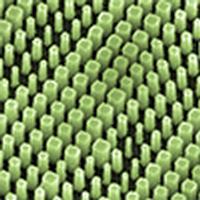Our official English website, www.x-mol.net, welcomes your
feedback! (Note: you will need to create a separate account there.)
Multifunctional 2.5D metastructures enabled by adjoint optimization
Optica ( IF 8.4 ) Pub Date : 2020-01-17 , DOI: 10.1364/optica.374787 Mahdad Mansouree , Hyounghan Kwon , Ehsan Arbabi , Andrew McClung , Andrei Faraon , Amir Arbabi
Optica ( IF 8.4 ) Pub Date : 2020-01-17 , DOI: 10.1364/optica.374787 Mahdad Mansouree , Hyounghan Kwon , Ehsan Arbabi , Andrew McClung , Andrei Faraon , Amir Arbabi

|
Optical metasurfaces are two-dimensional arrays of meta-atoms that modify different characteristics of light such as phase, amplitude, and polarization. One intriguing feature that distinguishes them from conventional optical components is their multifunctional capability. However, multifunctional metasurfaces with efficiencies approaching those of their single-functional counterparts require more degrees of freedom. Here we show that 2.5D metastructures, which are stacked layers of interacting metasurface layers, provide sufficient degrees of freedom to implement efficient multifunctional devices. The large number of design parameters and their intricate intercoupling make the design of multifunctional 2.5D metastructures a complex task, and unit-cell approaches to metasurface design produce suboptimal devices. We address this issue by designing 2.5D metastructures using the adjoint optimization technique. Instead of designing unit cells individually, our technique considers the structure as a whole, accurately accounting for inter-post and inter-layer coupling. As proof of concept, we experimentally demonstrate a double-wavelength metastructure, designed using adjoint optimization, that has significantly higher efficiencies than a similar device designed with a simplified approach conventionally used in metasurface design. The 2.5D metastructure architecture empowered by the optimization-based design technique is a general platform for realizing high-performance multifunctional components and systems.
中文翻译:

伴随优化实现的多功能2.5D元结构
光学超表面是变质的二维阵列,可改变光的不同特征(例如相位,振幅和偏振)。将它们与常规光学组件区分开的一个有趣特征是它们的多功能功能。然而,具有比单功能对应物更高的效率的多功能超表面需要更大的自由度。在这里,我们显示2.5D元结构是相互作用的超表面层的堆叠层,可提供足够的自由度来实现高效的多功能设备。大量的设计参数及其错综复杂的相互耦合使多功能2.5D元结构的设计成为一项复杂的任务,而用于元表面设计的晶胞方法会产生次优的设备。我们通过使用伴随优化技术设计2.5D元结构来解决此问题。代替单独设计单位单元,我们的技术考虑了整个结构,准确地考虑了柱间和层间耦合。作为概念验证,我们通过实验证明了使用伴随优化设计的双波长元结构,其效率比使用通常用于超表面设计的简化方法设计的类似设备要高得多。由基于优化的设计技术提供支持的2.5D元结构体系结构是实现高性能多功能组件和系统的通用平台。我们的技术从整体上考虑了结构,准确地考虑了柱间和层间耦合。作为概念验证,我们通过实验证明了使用伴随优化设计的双波长元结构,其效率比使用通常用于超表面设计的简化方法设计的类似设备要高得多。由基于优化的设计技术提供支持的2.5D元结构体系结构是实现高性能多功能组件和系统的通用平台。我们的技术从整体上考虑了结构,准确地考虑了柱间和层间耦合。作为概念验证,我们通过实验证明了使用伴随优化设计的双波长元结构,其效率比使用通常用于超表面设计的简化方法设计的类似设备要高得多。由基于优化的设计技术提供支持的2.5D元结构体系结构是实现高性能多功能组件和系统的通用平台。与使用通常用于超表面设计的简化方法设计的类似设备相比,该设备的效率明显更高。由基于优化的设计技术提供支持的2.5D元结构体系结构是实现高性能多功能组件和系统的通用平台。与使用通常用于超表面设计的简化方法设计的类似设备相比,该设备的效率明显更高。由基于优化的设计技术提供支持的2.5D元结构体系结构是实现高性能多功能组件和系统的通用平台。
更新日期:2020-01-21
中文翻译:

伴随优化实现的多功能2.5D元结构
光学超表面是变质的二维阵列,可改变光的不同特征(例如相位,振幅和偏振)。将它们与常规光学组件区分开的一个有趣特征是它们的多功能功能。然而,具有比单功能对应物更高的效率的多功能超表面需要更大的自由度。在这里,我们显示2.5D元结构是相互作用的超表面层的堆叠层,可提供足够的自由度来实现高效的多功能设备。大量的设计参数及其错综复杂的相互耦合使多功能2.5D元结构的设计成为一项复杂的任务,而用于元表面设计的晶胞方法会产生次优的设备。我们通过使用伴随优化技术设计2.5D元结构来解决此问题。代替单独设计单位单元,我们的技术考虑了整个结构,准确地考虑了柱间和层间耦合。作为概念验证,我们通过实验证明了使用伴随优化设计的双波长元结构,其效率比使用通常用于超表面设计的简化方法设计的类似设备要高得多。由基于优化的设计技术提供支持的2.5D元结构体系结构是实现高性能多功能组件和系统的通用平台。我们的技术从整体上考虑了结构,准确地考虑了柱间和层间耦合。作为概念验证,我们通过实验证明了使用伴随优化设计的双波长元结构,其效率比使用通常用于超表面设计的简化方法设计的类似设备要高得多。由基于优化的设计技术提供支持的2.5D元结构体系结构是实现高性能多功能组件和系统的通用平台。我们的技术从整体上考虑了结构,准确地考虑了柱间和层间耦合。作为概念验证,我们通过实验证明了使用伴随优化设计的双波长元结构,其效率比使用通常用于超表面设计的简化方法设计的类似设备要高得多。由基于优化的设计技术提供支持的2.5D元结构体系结构是实现高性能多功能组件和系统的通用平台。与使用通常用于超表面设计的简化方法设计的类似设备相比,该设备的效率明显更高。由基于优化的设计技术提供支持的2.5D元结构体系结构是实现高性能多功能组件和系统的通用平台。与使用通常用于超表面设计的简化方法设计的类似设备相比,该设备的效率明显更高。由基于优化的设计技术提供支持的2.5D元结构体系结构是实现高性能多功能组件和系统的通用平台。











































 京公网安备 11010802027423号
京公网安备 11010802027423号